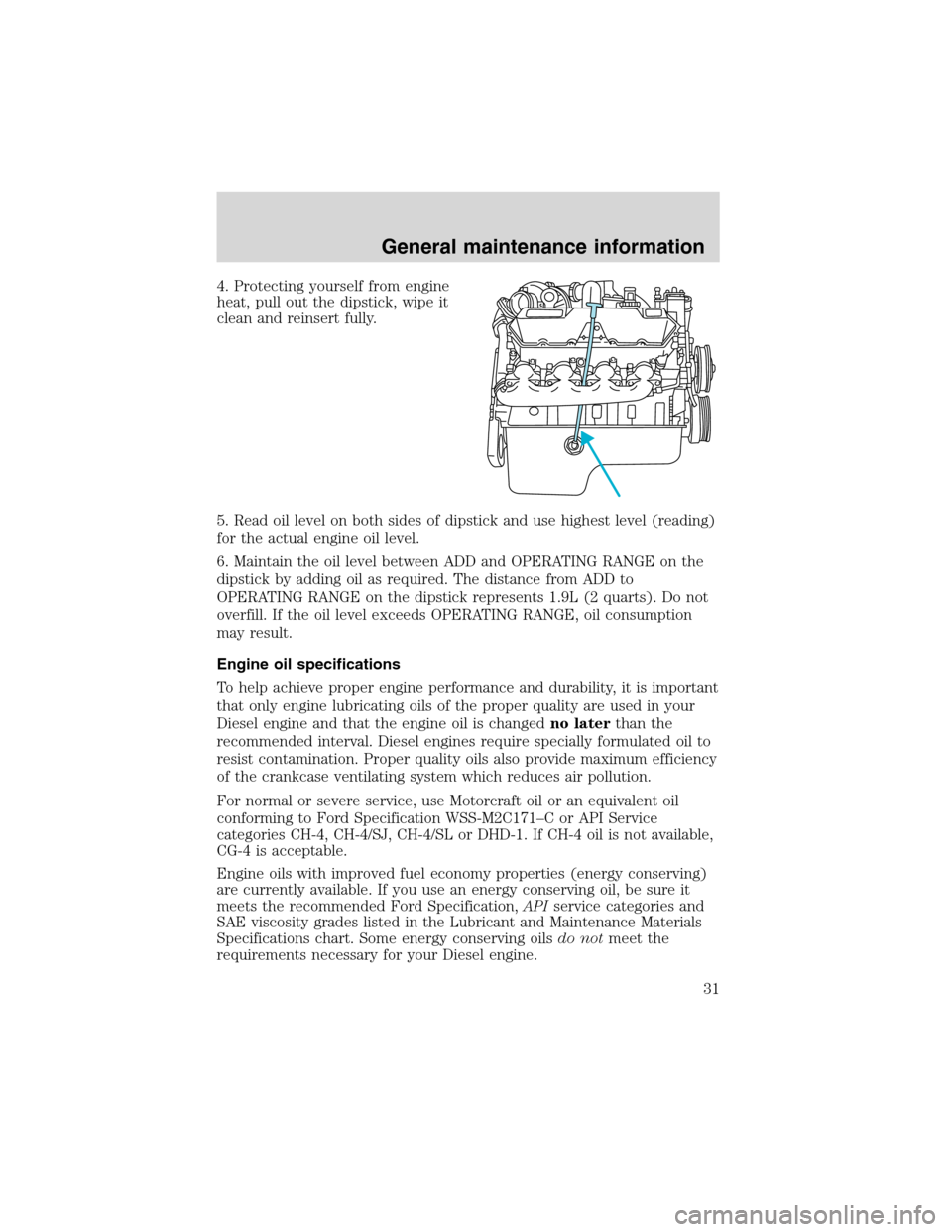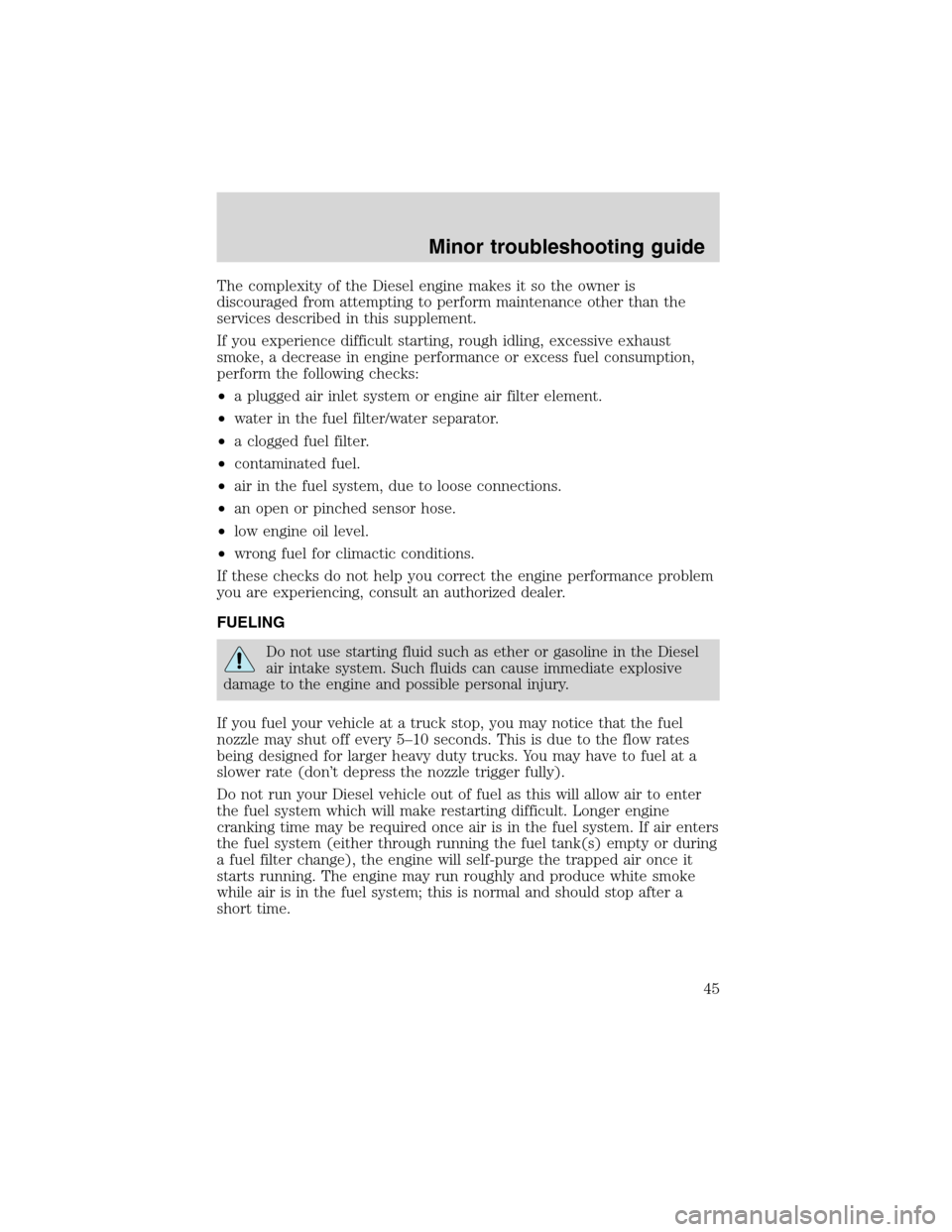2004 FORD E SERIES oil level
[x] Cancel search: oil levelPage 11 of 56

4. When the engine starts, release the key. The glow plugs will continue
to be activated for up to two minutes. If the engine is not started before
the activation ceases, the glow plug system must be reset by turning the
ignition key to OFF.
5. After the engine starts, allow it to idle for about 15 seconds. (Do not
increase engine speed until the oil pressure gauge indicates normal
pressure.)
STOPPING THE ENGINE
Turn the ignition to OFF. To prolong engine life (after extended high
speed or maximum GVW operation), it is recommended that a hot engine
be allowed to operate at low idle for about 7–10 minutes which would
allow sufficient time for the turbocharged engine to cool down.
COLD WEATHER OPERATION
Changing to a lighter grade engine oil also makes starting easier under
these conditions. Refer toEngine Oil Specificationsin theGeneral
maintenance informationchapter.
At temperatures below–7°C (20°F), Number 2–D Diesel fuel may
thicken enough to clog the fuel filter. Your engine is equipped with a fuel
filter/heater/water/separator to keep the wax melted which will help
prevent fuel filter clogging. However, if the engine starts but stalls after a
short time and will not restart, the fuel filter may be clogged. For best
results in cold weather, use Number 1–D Diesel fuel or“winterized”
Number 2–D Diesel fuel which has an additive to minimize wax
formation.
Your vehicle is also equipped with a bypass relief valve, located on the
in-tank fuel sending unit, which provides fuel flow to the engine if the
fuel pickup should become plugged by ice or wax. To allow this bypass
valve to function and avoid engine fuel starvation, it is recommended
that, during cold weather operation 0°C (32°F) or below, the fuel level in
your tank should not be allowed to drop below 1/4 full. This will help
prevent air from entering the fuel system and stalling the engine.
In cold weather below 0°C (32°F) your Diesel engine will slowly increase
to a higher idle speed if left idling in P (Park). The sound of the engine
may change also, as an exhaust device engages to improve heater
performance and reduce exhaust smoke.
Starting
11
Page 30 of 56

1. Apply a coating of clean Diesel fuel to the new fuel filter o-ring.
2. Install new fuel filter o-ring onto fuel filter element.
3. Install new fuel filter and o-ring into the fuel filter housing.
4. Tighten cap onto fuel filter housing slowly, allowing fuel to soak into
the fuel filter element. Tighten cap until it contacts the housing.
5. Install the resonator and resonator bolt.
6. Install the turbocharger heat shield, then the three bolts on the
turbocharger heat shield.
7. Connect the air inlet tube to the resonator, then tighten the clamp on
the air inlet tube.
8. Install the air cleaner(s), close the air cleaner cover, then close the
four retaining clamps on the air cleaner assembly.
9. Connect the battery ground cable, then all electrical connectors,
vacuum tubes and fasteners as necessary for installation.
10. Install the engine appearance cover.
After replacing the fuel filter, the engine will purge the trapped
air as it runs. The engine may run roughly and smoke until the air
is completely eliminated.
Using a fuel which has more than average impurities may require
the fuel filter to be replaced more frequently than the service
interval specifies.
ENGINE OIL
Checking engine oil level
Because it is normal to add some oil between oil changes, check your
engine oil level each time you stop for fuel. To check the engine oil level
consistently and accurately, the following procedure is recommended:
1. Have engine at normal operating temperature (at least into the
NORMAL range on the engine coolant temperature gauge).
2. Park the vehicle on a level surface, then turn off the engine and open
the hood.
3. Allow at least20 minutesafter engine shutdown to assure that the oil
contained in the upper parts of the engine has returned to the oil pan.
General maintenance information
30
Page 31 of 56

4. Protecting yourself from engine
heat, pull out the dipstick, wipe it
clean and reinsert fully.
5. Read oil level on both sides of dipstick and use highest level (reading)
for the actual engine oil level.
6. Maintain the oil level between ADD and OPERATING RANGE on the
dipstick by adding oil as required. The distance from ADD to
OPERATING RANGE on the dipstick represents 1.9L (2 quarts). Do not
overfill. If the oil level exceeds OPERATING RANGE, oil consumption
may result.
Engine oil specifications
To help achieve proper engine performance and durability, it is important
that only engine lubricating oils of the proper quality are used in your
Diesel engine and that the engine oil is changedno laterthan the
recommended interval. Diesel engines require specially formulated oil to
resist contamination. Proper quality oils also provide maximum efficiency
of the crankcase ventilating system which reduces air pollution.
For normal or severe service, use Motorcraft oil or an equivalent oil
conforming to Ford Specification WSS-M2C171–C or API Service
categories CH-4, CH-4/SJ, CH-4/SL or DHD-1. If CH-4 oil is not available,
CG-4 is acceptable.
Engine oils with improved fuel economy properties (energy conserving)
are currently available. If you use an energy conserving oil, be sure it
meets the recommended Ford Specification,APIservice categories and
SAE viscosity grades listed in the Lubricant and Maintenance Materials
Specifications chart. Some energy conserving oilsdo notmeet the
requirements necessary for your Diesel engine.
General maintenance information
31
Page 37 of 56

Rotunda Battery and Antifreeze Tester, 014–R1060). The level of coolant
should be maintained at the“cold full”of“cold fill range”level in the
coolant reservoir. If the level falls below, add coolant per the instructions
in theAdding Engine Coolantsection.
Your vehicle was factory-filled with a 50/50 engine coolant and water
concentration. If the concentration of coolant falls below 40% or above
60%, the engine parts could become damaged or not work properly.A
50–50 mixture of coolant and water provides the following:
•freeze protection down to -36°C (-34°F).
•boiling protection up to 129°C (265°F).
•protection against rust and other forms of corrosion.
•enables calibrated gauges to work properly.
When the engine is cold, check the level of the engine coolant in the
reservoir.
•The engine coolant should be at the“cold fill level”or within the“cold
fill range”as listed on the engine coolant reservoir (depending upon
application).
•Refer to the scheduled maintenance guide for service interval
schedules.
•Be sure to read and understandPrecautions when servicing your
vehiclein your owner guide.
If the engine coolant has not been checked at the recommended interval,
the engine coolant reservoir may become low or empty. If the reservoir is
low or empty, add engine coolant to the reservoir. Refer toAdding
engine coolantin this chapter.
Note:Automotive fluids are not interchangeable; do not use engine
coolant, antifreeze or windshield washer fluid outside of its specified
function and vehicle location.
Vehicles with Diesel engines typically are used to carry heavy loads and
accumulate mileage rapidly. These two factors cause the additives in the
coolant to“wear out”in a shorter time. For vehicles equipped with green
coolant, Ford recommends an interim service interval performed at 12
months or 24,000 km (15,000 miles), whichever occurs first. Add
237–295 ml (8–10 oz.) of supplemental coolant additive FW-16 to the
cooling system. For vehicles with extensive idling time, add 237–295 ml
(8–10 oz.) of coolant additive FW-16 after every 500 hours of operation.
(see scheduled maintenance guide). For vehicles equipped with yellow
coolant (Extended Life Coolant), the service interval is five years or
General maintenance information
37
Page 40 of 56

Whenever coolant has been added, the coolant level in the coolant
reservoir should be checked the next few times you drive the vehicle. If
necessary, add enough 50/50 concentration of engine coolant and
distilled water to bring the liquid level to the proper level.
If you have to add more than 1.0 liter (1.0 quart) of engine coolant per
month, have your dealer check the engine cooling system. Your cooling
system may have a leak. Operating an engine with a low level of coolant
can result in engine overheating and possible engine damage.
Replacing coolant
A coolant mixture of 50% coolant concentrate and 50% water is
recommended to maintain best overall performance. To avoid damaging
the engine and radiator, the coolant concentrate should not exceed 60%.
When refilling the coolant system either as part of the regular
maintenance (refer to the scheduled maintenance guide), or due to
service performed, adhere to the following instructions:
1. Drain and flush the cooling system to remove dirt deposits, oil, rust
particles.
Note:When filling the system with Motorcraft Premium Engine Coolant
(green-colored) or equivalent meeting Ford specification
ESE-M97B44–A, a supplemental coolant additive is required. Refer to
Adding Coolantsection to determine the coolant type in your vehicle.
Add 1.89L (4 pints) of Motorcraft Heavy Duty Cooling System Additive
FW-16 or equivalent meeting Ford specification ESN-M99B169–A,
directly to the cooling system. An additional 237–295 ml (8–10 oz.) of
supplemental coolant additive FW-16 should be added at 24,000 km
(15,000 mile) intervals to maintain proper concentration.Do not use
this additive with yellow-colored coolant meeting Ford
specification WSS-M97B51–A1.
2. Fill the coolant reservoir with the specified coolant/water mixture until
the level stabilizes at the top hose fitting. Replace and tighten cap. Fill
the coolant bottle to the cold fill mark.
3. Reinstall the coolant bottle cap.
4. Start and idle engine until the radiator upper hose is warm
(approximately 10–15 minutes). If the hose does not get warm then
repeat at a higher engine speed.
5. Immediately shut off engine. Allow engine to cool before removing
coolant bottle cap. Cautiously remove coolant bottle cap and add coolant
to Cold Fill mark.
General maintenance information
40
Page 45 of 56

The complexity of the Diesel engine makes it so the owner is
discouraged from attempting to perform maintenance other than the
services described in this supplement.
If you experience difficult starting, rough idling, excessive exhaust
smoke, a decrease in engine performance or excess fuel consumption,
perform the following checks:
•a plugged air inlet system or engine air filter element.
•water in the fuel filter/water separator.
•a clogged fuel filter.
•contaminated fuel.
•air in the fuel system, due to loose connections.
•an open or pinched sensor hose.
•low engine oil level.
•wrong fuel for climactic conditions.
If these checks do not help you correct the engine performance problem
you are experiencing, consult an authorized dealer.
FUELING
Do not use starting fluid such as ether or gasoline in the Diesel
air intake system. Such fluids can cause immediate explosive
damage to the engine and possible personal injury.
If you fuel your vehicle at a truck stop, you may notice that the fuel
nozzle may shut off every 5–10 seconds. This is due to the flow rates
being designed for larger heavy duty trucks. You may have to fuel at a
slower rate (don’t depress the nozzle trigger fully).
Do not run your Diesel vehicle out of fuel as this will allow air to enter
the fuel system which will make restarting difficult. Longer engine
cranking time may be required once air is in the fuel system. If air enters
the fuel system (either through running the fuel tank(s) empty or during
a fuel filter change), the engine will self-purge the trapped air once it
starts running. The engine may run roughly and produce white smoke
while air is in the fuel system; this is normal and should stop after a
short time.
Minor troubleshooting guide
45